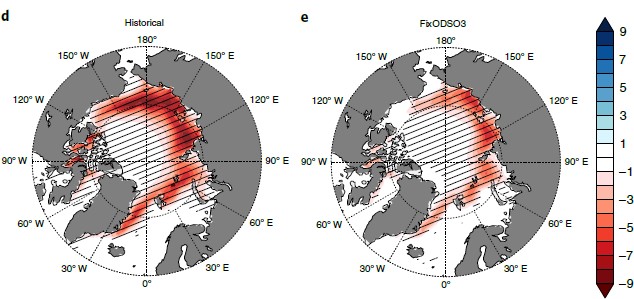 n what might be the most significant discovery in climate studies in
decades—maybe ever—a group of researchers headed by L.M. Polvani of
Columbia University published a bombshell
short report in
Nature Climate Change[1] that threatens to overturn a half century
of focus on carbon dioxide as the principal driver of climate change.
n what might be the most significant discovery in climate studies in
decades—maybe ever—a group of researchers headed by L.M. Polvani of
Columbia University published a bombshell
short report in
Nature Climate Change[1] that threatens to overturn a half century
of focus on carbon dioxide as the principal driver of climate change.
This finding has huge implications for how humans deal with climate. If one reads between the lines, it is clear that it strikes a devastating blow to the claims of climate activists that science backs up their plans to dismantle our “carbon-based” economy.
As I discussed here and here back in 2016, computer simulations by Dr Q.-B. Lu of the University of Waterloo in Canada showed that up to 97% of the 20th century warming can be accounted for, not by CO2, but by variations in solar flux and by CFCs (chlorofluorocarbons).
Lu's calculations explained many peculiarities about the climate record, including the apparent temperature increase after WWII and the much slower increase, known as the pause, that began a few years after the 1987 Montreal Protocol banning CFCs went into effect. Climate studies researchers ignored Lu's work (and still do: he is not cited in the Polvani et al. paper).
The Montreal Protocol came into effect after CFCs were deemed responsible for the Antarctic ozone hole. The chemists who came up with a theory to explain it were awarded the Nobel prize; since CFCs were phased out, ozone hole advocates have scrutinized every bit of data, notably the temporary shrinking of the hole a few years ago, in hopes of confirming the theory.

Arctic sea ice map showing measured percentage changes in sea ice concentration. d= historical, e= computed in their FixODSO3 model with CFC held at 1955 levels. (Source: Polvani et al., Nature Climate Change, Fig. 2. [1])
The radiative forcing of ozone depletion is too small by itself to affect temperature significantly. Despite much research, the dynamics of the so-called ozone hole are still not well understood. According to the theory, ozone depletion happens in two steps. First a prolonged period of extreme cold and darkness, which only occurs over Antarctica, allows a free radical reaction to proceed; then in the spring the radicals are activated by the returning UV light and destroy the ozone.
Many people have forgotten the hysteria in the press about the ozone layer: sheep dying in Argentina, people reporting skin cancer, and so on. But even without any ozone layer, the amount of UV radiation at those latitudes would still have been far less than on a sunny day near the equator.
It has long been known that CFC-11 and CFC-12 are 19,000 and 23,000 times more radiatively efficient, respectively, than CO2 as greenhouse gases. It is also widely accepted (though rarely mentioned in the press) that CFCs account for much of the worldwide anthropogenic radiative forcing. Polvani et al. used a computer model to ask how much warming in the Arctic was due to CFCs, which they refer to as ozone-depleting substances or ODS. They conclude that half of the warming and sea ice loss between 1955 and 2005 was due to ODS. They also conclude that ODS were responsible for 0.27° of the 0.59° of global warming, or one-third of the total, over the same period.
The model, called FixODSO3, purports to predict what would have happened if ODS and ozone had remained constant since 1955. The answer is: not much. Their Fig. 2 (part of which is shown above) shows the statistically significant trends in Arctic ice by hashing, and the percent decrease by shades of red. A second model, called FixODS, which holds ODS constant but keeps stratospheric ozone at its historically varying levels, gave the same result as FixODSO3, indicating that ozone depletion was not likely to be a factor: CFCs were acting as greenhouse gases, not by depleting ozone.
Their temperature maps show a similar effect, with Arctic temperature changes dropping from 1.59 to 0.82 when CFCs are removed. CFCs account for 58% of sea ice loss and over 40% of the global temperature increase (warming drops from 0.60 to around 0.35K). In other words, the effect of CFCs is by no means limited to the Arctic Ocean.
They characterize these findings as “very robust.” It pays to remember, however, that these are all computer simulations, and the global circulation models used by climate researchers have been criticized for the amount of “tweaking” they need to arrive at the correct answer.

Is the carbon dioxide theory now defunct? My model, which utilizes a magic eight ball, says maybe, or possibly maybe not.
There are several questions left unanswered.
- What would have happened if there had been no CFCs at all?
- Bearing in mind that the CO2 theory predicted the largest amounts of warming at the poles, it seems logical to conclude that at least the same percentage of the anthropogenic global temperature increases are attributable not to CO2, but to CFCs—which are banned and rapidly declining.
- How sure are we that it's only 40% and not, say, half or three quarters? Well, we have a rule in science: every paper must end with the phrase “more research is needed.”
- Why didn't the global circulation models predict this? This is sort of what models are for.
- Why do we fall for fads like CO2 warming over and over again, and why were the media so uncritical?
Meanwhile we have rubbish like this to contend with in the popular press: Some guy named Per Holmberg just re-translated some Viking runes and claims that the Vikings predicted global warming over a thousand years ago and that they foresaw that global warming would cause the 2020 Australian brush fires.
It should be obvious that these results, if true, mean that global temperatures will decrease instead of increase as atmospheric CFC concentrations continue to decline. They also mean that the ecological catastrophe that some activists are predicting won't happen, even if CO2 levels remain unchanged.
1. Polvani, L. M., Previdi, M., England, M. R., Chiodo, G., Smith, K. L. Nature Clim. Change. https://doi.org/10.1038/s41558-019-0677-4 (2020).
jan 22 2020, 6:40 am. last edited jan 29 2020, 4:25 am
